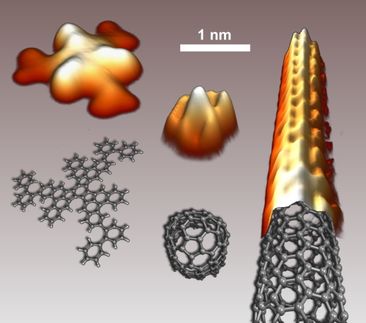Mechanical properties of nanomaterials are altered due to electric field
Mechanical properties of nanomaterials can be altered due to the application of voltage, University of Wyoming researchers have discovered.
The researchers, led by TeYu Chien, a UW assistant professor in the Department of Physics and Astronomy, determined that the electric field is responsible for alterating the fracture toughness of nanomaterials, which are used in state-of-the-art electronic devices. It is the first observed evidence that the electric field changes the fracture toughness at a nanometer scale.
This finding opens the way for further investigation of nanomaterials regarding electric field-mechanical property interactions, which is extremely important for applications and fundamental research.
Other researchers who contributed to the paper are from the University of Arkansas, University of Tennessee and Argonne National Laboratory in Argonne, Ill.
Chien and his research team studied the surfaces of the fractured interfaces of ceramic materials, including lanthanum nickelate and strontium titanate with a small amount of niobium. The researchers revealed that strontium titanate, within a few nanometers of the interfaces, fractured differently from the strontium titanate away from the interfaces.
The two ceramic materials were chosen because one is a metallic oxide while the other is a semiconductor. When the two types of materials come into contact with each other, an intrinsic electric field will automatically be formed in a region, known as the Schottky barrier, near the interface, Chien explains. The Schottky barrier refers to the region where an intrinsic electric field is formed at metal/semiconductor interfaces.
The intrinsic electric field at interfaces is an inevitable phenomenon whenever one material is in contact with another. The electric field effects on the mechanical properties of materials are rarely studied, especially for nanomaterials. Understanding electric field effects is extremely important for applications of nanoelectromechanical system (NEMS), which are devices, such as actuators, integrating electrical and mechanical functionalities on the nanoscale.
For NEMS materials made in nanoscale, understanding the mechanical properties affected by electric fields is crucial for full control of device performance. The observations in this study pave the way to better understand the mechanical properties of nanomaterials.
"The electric field changes the inter-atomic bond length in the crystal by pushing positively and negatively charged ions in opposite directions," Chien says. "Altering bond length changes bond strength. Hence, the mechanical properties, such as fracture toughness."
"The whole picture is this: The intrinsic electric field in the Schottky barrier was created at the interfaces. This then polarized the materials near the interfaces by changing the atomic positions in the crystal. The changed atomic positions altered the inter-atomic bond length inside the materials to change the mechanical properties near the interfaces," Chien summarizes.
Original publication
Most read news
Original publication
TeYu Chien, Jian Liu, Andrew J. Yost, Jak Chakhalian, John W. Freeland & Nathan P. Guisinger; "Built-in Electric Field Induced Mechanical Property Change at the Lanthanum Nickelate/Nb-doped Strontium Titanate Interfaces"; Scientific Reports; 2016
Topics
Organizations
Other news from the department science

Get the chemical industry in your inbox
By submitting this form you agree that LUMITOS AG will send you the newsletter(s) selected above by email. Your data will not be passed on to third parties. Your data will be stored and processed in accordance with our data protection regulations. LUMITOS may contact you by email for the purpose of advertising or market and opinion surveys. You can revoke your consent at any time without giving reasons to LUMITOS AG, Ernst-Augustin-Str. 2, 12489 Berlin, Germany or by e-mail at revoke@lumitos.com with effect for the future. In addition, each email contains a link to unsubscribe from the corresponding newsletter.

























































